Multi-Objective Optimal Design and Operation of Heat Exchanger Networks with Controllability Consideration
Abstract
1. Introduction
2. Problem Statement
3. Model Formulations
3.1. Methodology Framework
3.2. Heat Exchanger Network Synthesis
3.3. Control Structure Selection
3.3.1. Minimization of Control Loop Interaction
3.3.2. Extended DP&C Model Based on Superstructure Representation
3.4. Strategy for Solutions to Multi-Objective Optimization of HEN Based on Partition of ΔTmin Intervals
3.4.1. Methods for Single Objective Optimization of HEN
3.4.2. Methods for Multi-Objective Optimization of HEN
4. Results and Discussion
4.1. Partition of ΔTmin Intervals for Synthesizing the Controllable HEN
4.2. Single Objective Optimization of HEN Considering Control Structure Selection
4.3. Multi-Objective Optimization of HEN Considering Control Structure Selection
4.4. Further Analysis and Comparison of Results
5. Conclusions
Author Contributions
Funding
Institutional Review Board Statement
Informed Consent Statement
Data Availability Statement
Conflicts of Interest
Nomenclature
| Symbols | |
| A | area of heat exchanger, m2 |
| B | auxiliary coefficient matrix of DP&C model |
| c | cost coefficient, $·kW−1·y−1 |
| D | auxiliary coefficient matrix of DP&C model |
| Dm | auxiliary coefficient matrix of DP&C model |
| D+/D− | Euclidean distance |
| e | information entropy |
| F | auxiliary variable |
| Fcph/Fcpc | heat capacity flow rate, kW·K−1 |
| g | auxiliary variable |
| h | heat transfer film coefficient, kW·m−2·K−1 |
| H | auxiliary variable |
| K | bypass fraction, % |
| M | auxiliary parameter |
| N | auxiliary variable |
| Nstream | number of streams |
| Nbypass | number of bypasses |
| O | auxiliary variable |
| P | auxiliary variable |
| Q | heat load, kW |
| r | auxiliary parameter |
| Th/Tc | stream temperature for hot and cold sides, K |
| V | structure matrix in DP&C model |
| X | control pairing matrix |
| z | binary variable indicating the existence of heat exchangers |
| α | cost coefficient related to units, $·kW−1·y−1 |
| αα | entropy |
| β | cost coefficient related to heat exchanger area, $·kW−1·y−1 |
| λ | weighting coefficient, 0 ≤ λ ≤ 1 |
| auxiliary parameter | |
| evaluation function | |
| weighting coefficient | |
| Superscripts | |
| CU | cold utility |
| HU | hot utility |
| HE | heat exchanger |
| IN | stream inlet |
| OUT | stream outlet |
| Subscripts | |
| i | hot process stream |
| j | cold process stream |
| k | stage in step-wise superstructure |
| m | row of stationary gain matrix |
| n | column of stationary gain matrix |
Appendix A
| Interval | Heat Exchanger Area/(m2) | Heater or Cooler Area/(m2) | TAC/($·y−1) | ||
|---|---|---|---|---|---|
| HE1 | HE2 | HE3 | |||
| I (5~12 K) | 25.20 | 39.51 | 5.33 | 0.80, 3.21 | 108,227 |
| II (12~28 K) | 26.80 | 5.38 | 11.17 | 1.27, 4.16 | 114,126 |
| III (28~40 K) | 2.84 | 4.47 | 22.06 | 1.14, 3.90 | 124,415 |
References
- Chen, G.Q.; Wu, X.F. Energy overview for globalized world economy: Source, supply chain and sink. Renew. Sustain. Energy Rev. 2017, 69, 735–749. [Google Scholar] [CrossRef]
- Wang, B.H.; Arsenyeva, O.; Zeng, M.; Klemeš, J.J.; Varbanov, P.S. An advanced Grid Diagram for heat exchanger network retrofit with detailed plate heat exchanger design. Energy 2022, 248, 123485. [Google Scholar] [CrossRef]
- Leitold, D.; Vathy-Fogarassy, A.; Abonyi, J. Design-oriented structural controllability and observability analysis of heat exchanger networks. Chem. Eng. Trans. 2018, 70, 595–600. [Google Scholar] [CrossRef]
- Trainor, M.; Giannakeas, V.; Kiss, C.; Ricardez-Sandoval, L.A. Optimal process and control design under uncertainty: A methodology with robust feasibility and stability analyses. Chem. Eng. Sci. 2013, 104, 1065–1080. [Google Scholar] [CrossRef]
- Escobar, M.; Trierweiler, J.O.; Grossmann, I.E. Simultaneous synthesis of heat exchanger networks with operability considerations: Flexibility and controllability. Comput. Chem. Eng. 2013, 55, 158–180. [Google Scholar] [CrossRef]
- Gu, S.W.; Zhang, L.; Zhuang, Y.; Li, W.D.; Du, J. Two-tier control structure design methodology applied to heat exchanger networks. Chin. J. Chem. Eng. 2022, 47, 231–244. [Google Scholar] [CrossRef]
- Feng, Z.Y.; Guo, H.R.; She, J.H.; Xu, L. Weighted sensitivity design of multivariable PID controllers via a new iterative LMI approach. J. Process Control 2022, 110, 24–34. [Google Scholar] [CrossRef]
- Feng, Z.M.; Wang, W.H.; Xu, D.; Rangaiah, G.P.; Dong, L.C. Dynamic controllability of temperature difference control for the operation of double liquid-only side-stream distillation. Comput. Chem. Eng. 2022, 164, 107870. [Google Scholar] [CrossRef]
- Luppi, P.A.; Braccia, L.; Zumoffen, D. Optimal measurement selection and principal component analysis-based combination as controlled variables. Ind. Eng. Chem. Res. 2021, 60, 457–472. [Google Scholar] [CrossRef]
- Bottari, A.; Marchetti, P.A.; Marchetti, A.G. Self-optimizing steady-state back-off approach for control structure selection. Ind. Eng. Chem. Res. 2019, 58, 13699–13717. [Google Scholar] [CrossRef]
- Luppi, P.A.; Braccia, L.; Patrone, M.; Zumoffen, D. Control allocation based fault-tolerant strategy for a bio-ethanol processor system integrated to a PEM fuel cell. J. Process Control 2019, 81, 40–53. [Google Scholar] [CrossRef]
- He, M.J.; Cai, W.J.; Ni, W.; Xie, L.H. RNGA based control system configuration for multivariable processes. J. Process Control 2009, 19, 1036–1042. [Google Scholar] [CrossRef]
- Luyben, W.L. Simplified plantwide control structure for the diethyl oxalate process. Comput. Chem. Eng. 2019, 126, 451–464. [Google Scholar] [CrossRef]
- Patilas, C.S.; Kookos, I.K. A quadratic approximation of the back-off methodology for the control structure selection problem. Comput. Chem. Eng. 2020, 143, 107114. [Google Scholar] [CrossRef]
- Yin, X.Y.; Liu, J.F. Input-output pairing accounting for both structure and strength in coupling. AIChE J. 2017, 63, 1226–1235. [Google Scholar] [CrossRef]
- Kookos, I.K.; Perkins, J.D. Heuristic-Based Mathematical Programming Framework for Control Structure Selection. Ind. Eng. Chem. Res. 2001, 40, 2079–2088. [Google Scholar] [CrossRef]
- Elsheikh, A.H.; Panchal, H.N.; Sengottain, S.; Alsaleh, N.A.; Ahmadein, M. Applications of Heat Exchanger in Solar Desalination: Current Issues and Future Challenges. Water 2022, 14, 852. [Google Scholar] [CrossRef]
- Elsheikh, A.H.; Panchal, H.; Ahmadein, M.; Mosleh, A.O.; Sadasivuni, K.K.; Alsaleh, N.A. Productivity forecasting of solar distiller integrated with evacuated tubes and external condenser using artificial intelligence model and moth-flame optimizer. Case Stud. Therm. Eng. 2021, 28, 101671. [Google Scholar] [CrossRef]
- Faes, W.; Bael, J.V.; Lecompte, S.; Verbeken, K.; Paepe, M.D. Optimization of heat exchanger design taking corrosion into account. Therm. Sci. Eng. Prog. 2022, 30, 101277. [Google Scholar] [CrossRef]
- Bachler, S.; Wurm, J.; Woittennek, F. Open-loop temperature control for a distributed parameter model of a pipe. IFAC-Pap. 2020, 53, 7765–7770. [Google Scholar] [CrossRef]
- Pekař, L.; Prokop, R. Algebraic robust control of a closed circuit heating-cooling system with a heat exchanger and internal loop delays. Appl. Therm. Eng. 2017, 113, 1464–1474. [Google Scholar] [CrossRef]
- Bakošová, M.; Oravec, J. Robust model predictive control for heat exchanger network. Appl. Therm. Eng. 2014, 73, 924–930. [Google Scholar] [CrossRef]
- Liu, L.L.; Li, C.Y.; Gu, S.W.; Zhang, L.; Du, J. Optimization-based framework for the synthesis of heat exchanger networks incorporating controllability. Energy 2020, 208, 118292. [Google Scholar] [CrossRef]
- Gu, S.W.; Zhang, L.; Zhuang, Y.; Du, J.; Shao, C. Integrated synthesis and control of heat exchanger networks with dynamic flexibility consideration. Appl. Therm. Eng. 2023, 218, 119304. [Google Scholar] [CrossRef]
- Kang, L.X.; Liu, Y.Z.; Liang, X.Q. Multi-objective optimization of heat exchanger networks based on analysis of minimum temperature difference and accumulated CO2 emissions. Appl. Therm. Eng. 2015, 87, 736–748. [Google Scholar] [CrossRef]
- Yee, T.F.; Grossmann, I.E. Simultaneous optimization models for heat integrations-II. Heat exchanger network synthesis. Comput. Chem. Eng. 1990, 14, 1165. [Google Scholar] [CrossRef]
- Yan, Q.Z.; Yang, Y.H.; Huang, Y.L. Cost-effective bypass design of highly controllable heat-exchanger networks. AIChE J. 2001, 47, 2253–2276. [Google Scholar] [CrossRef]
- Zhu, Q.; Ren, Z.F. A double four-point probe method for reliable measurement of energy conversion efficiency of thermoelectric materials. Energy 2020, 191, 116599. [Google Scholar] [CrossRef]
- Ehrgott, M. Multicriteria Optimization, 2nd ed.; Springer: Berlin/Heidelberg, Germany, 2010; pp. 121–155. [Google Scholar]
- Zhang, Q.; Grossmann, I.E.; Lima, R.M. On the relation between flexibility analysis and robust optimization for linear systems. AIChE J. 2016, 62, 3109–3123. [Google Scholar] [CrossRef]
- Kariwala, V.; Cao, Y. Multiobjective Control Structure Design: A Branch and Bound Approach. Ind. Eng. Chem. Res. 2012, 51, 6064–6070. [Google Scholar] [CrossRef]
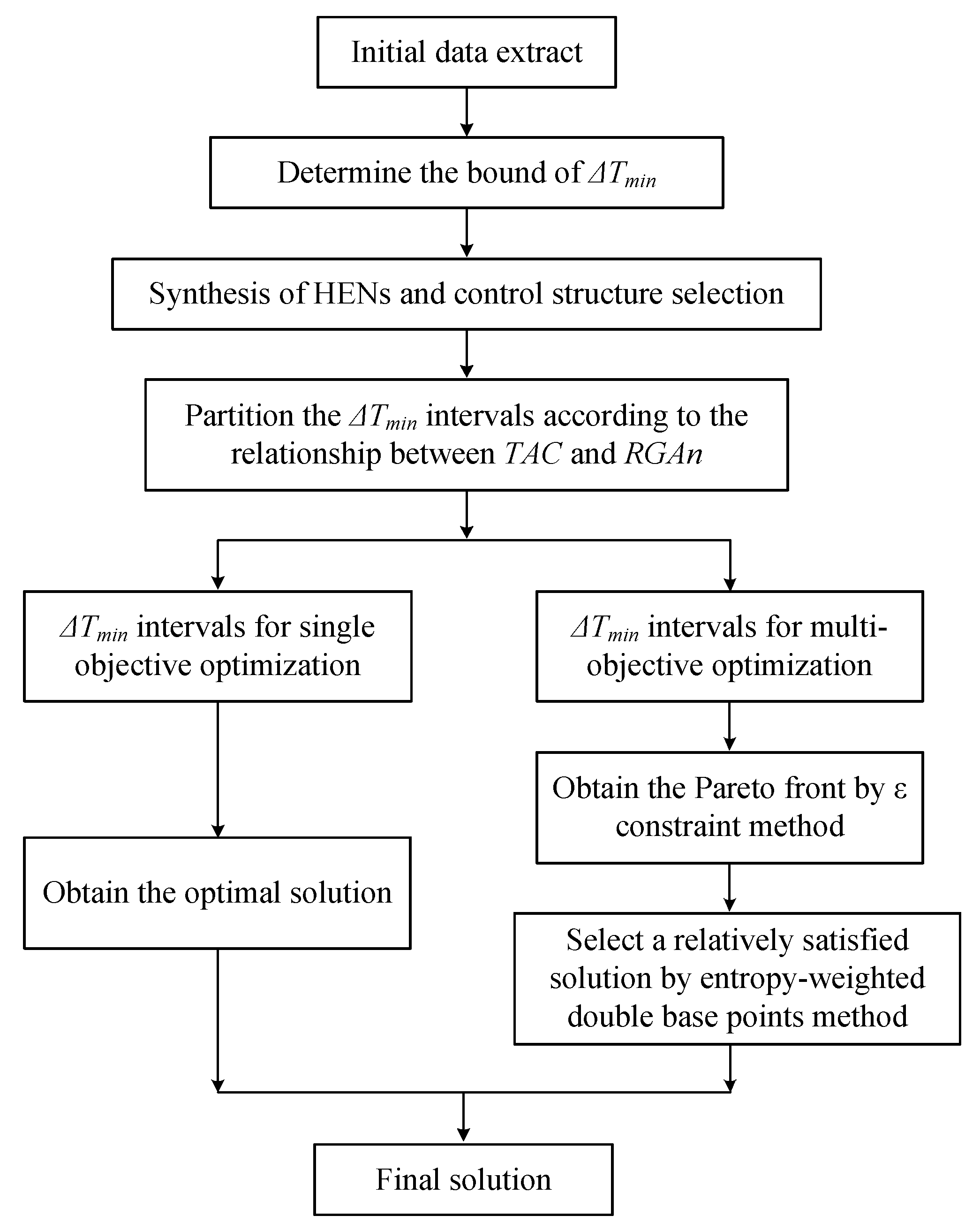
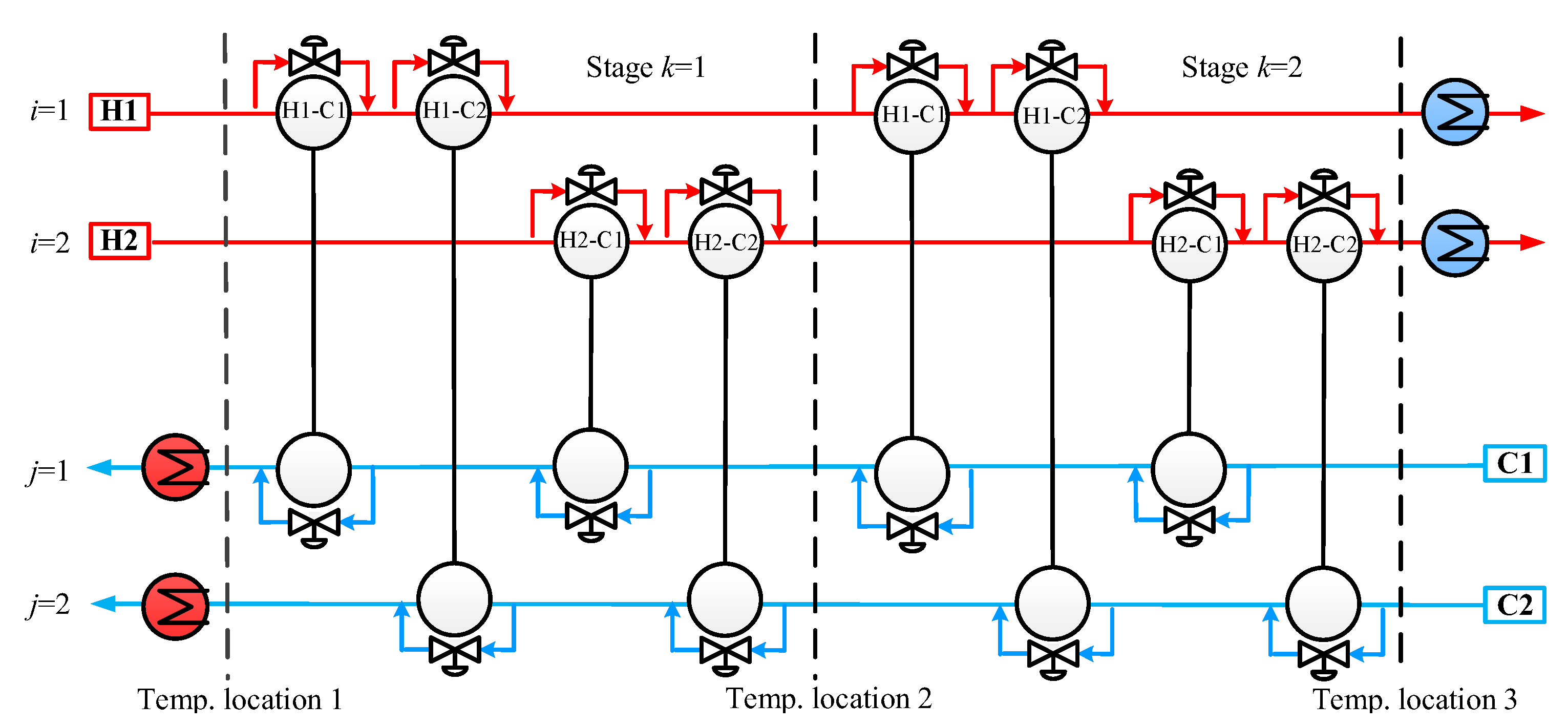
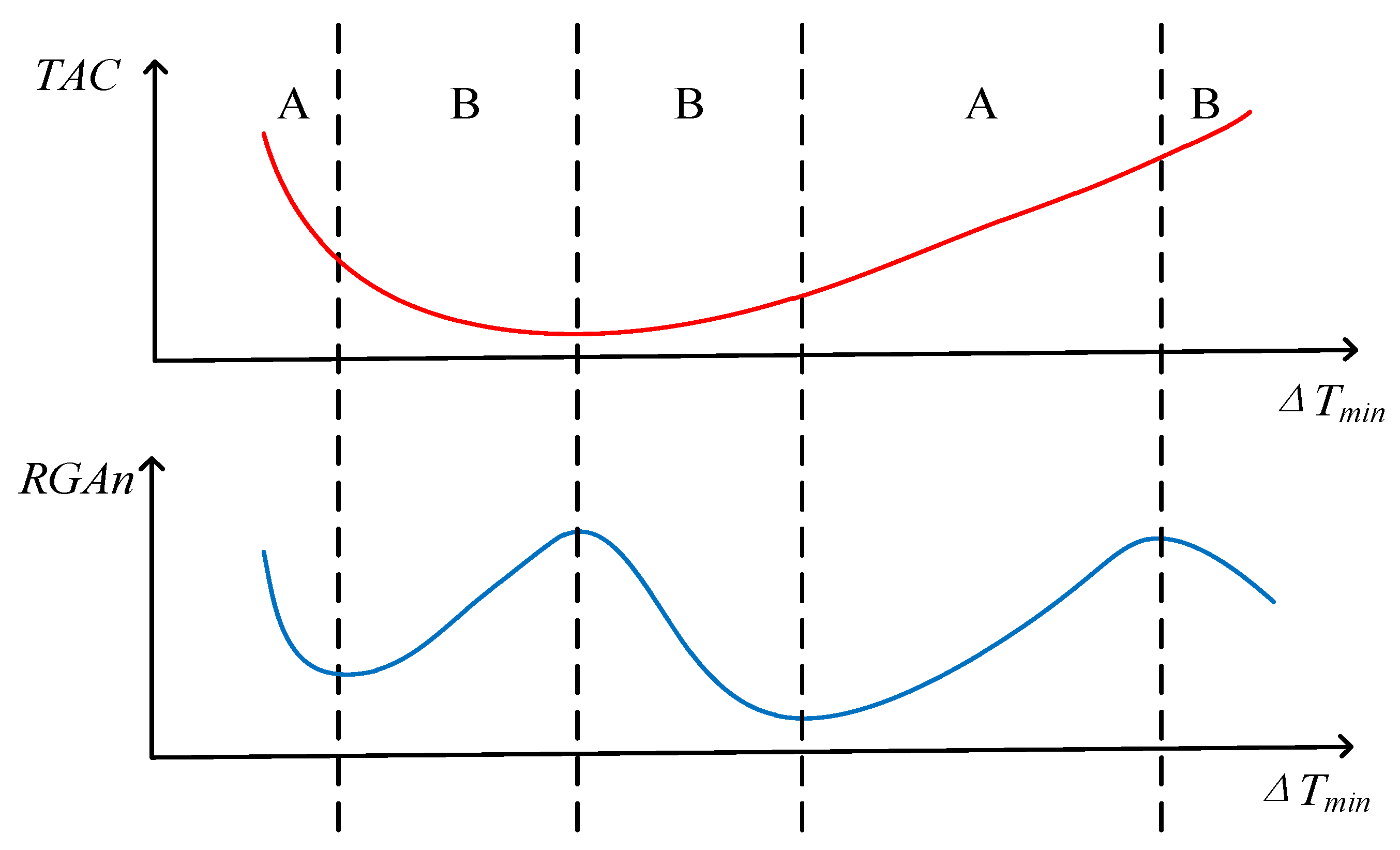
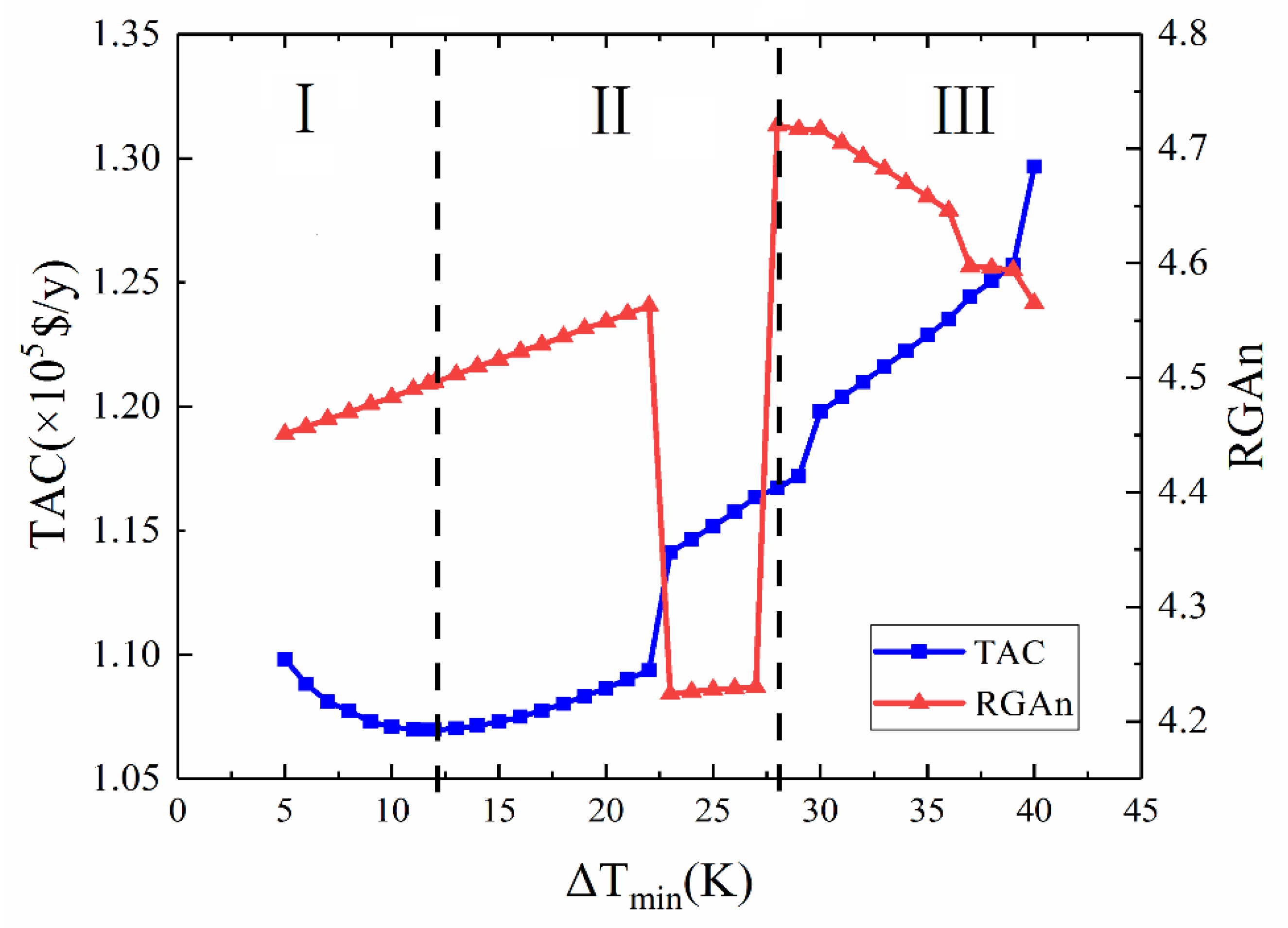

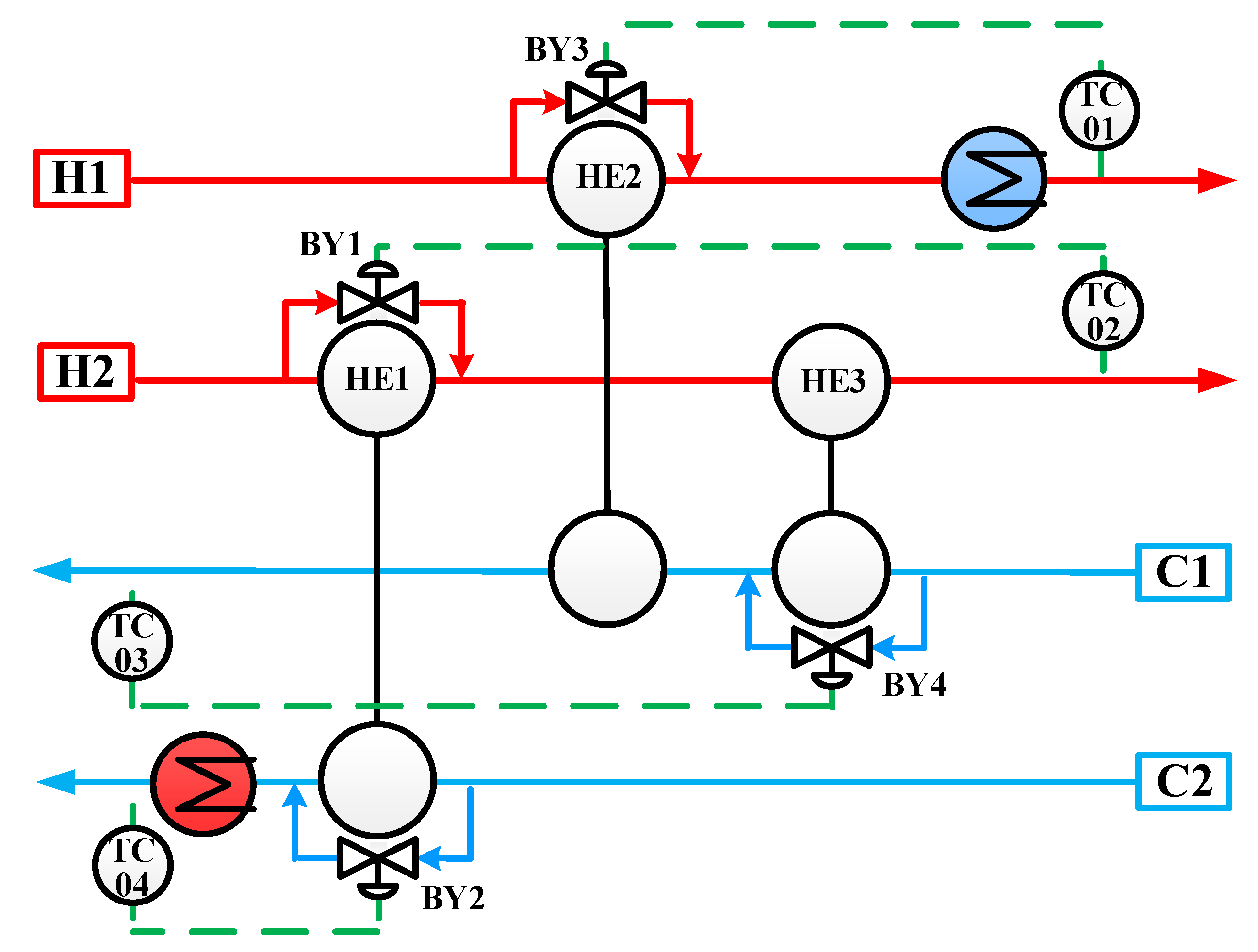
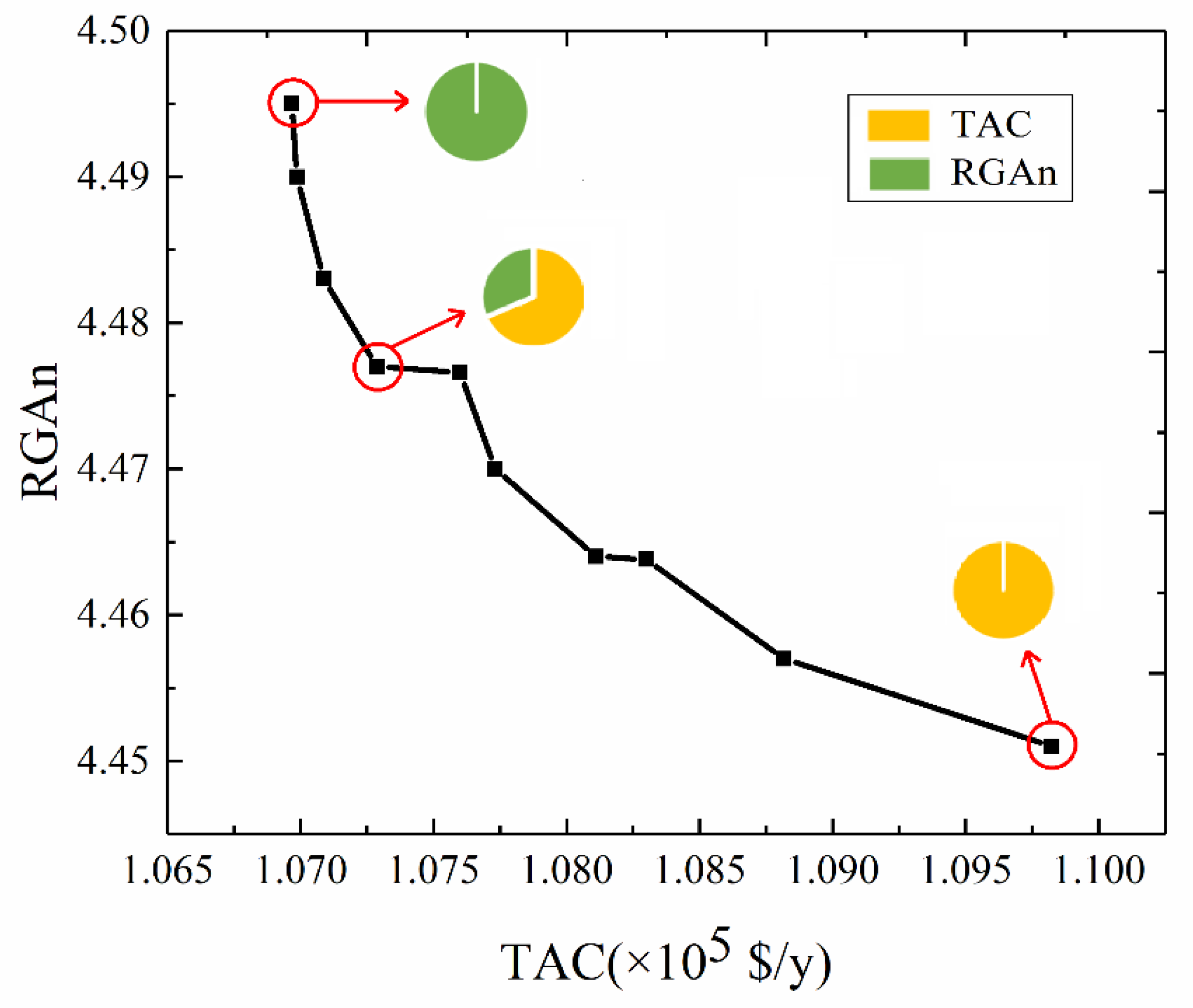

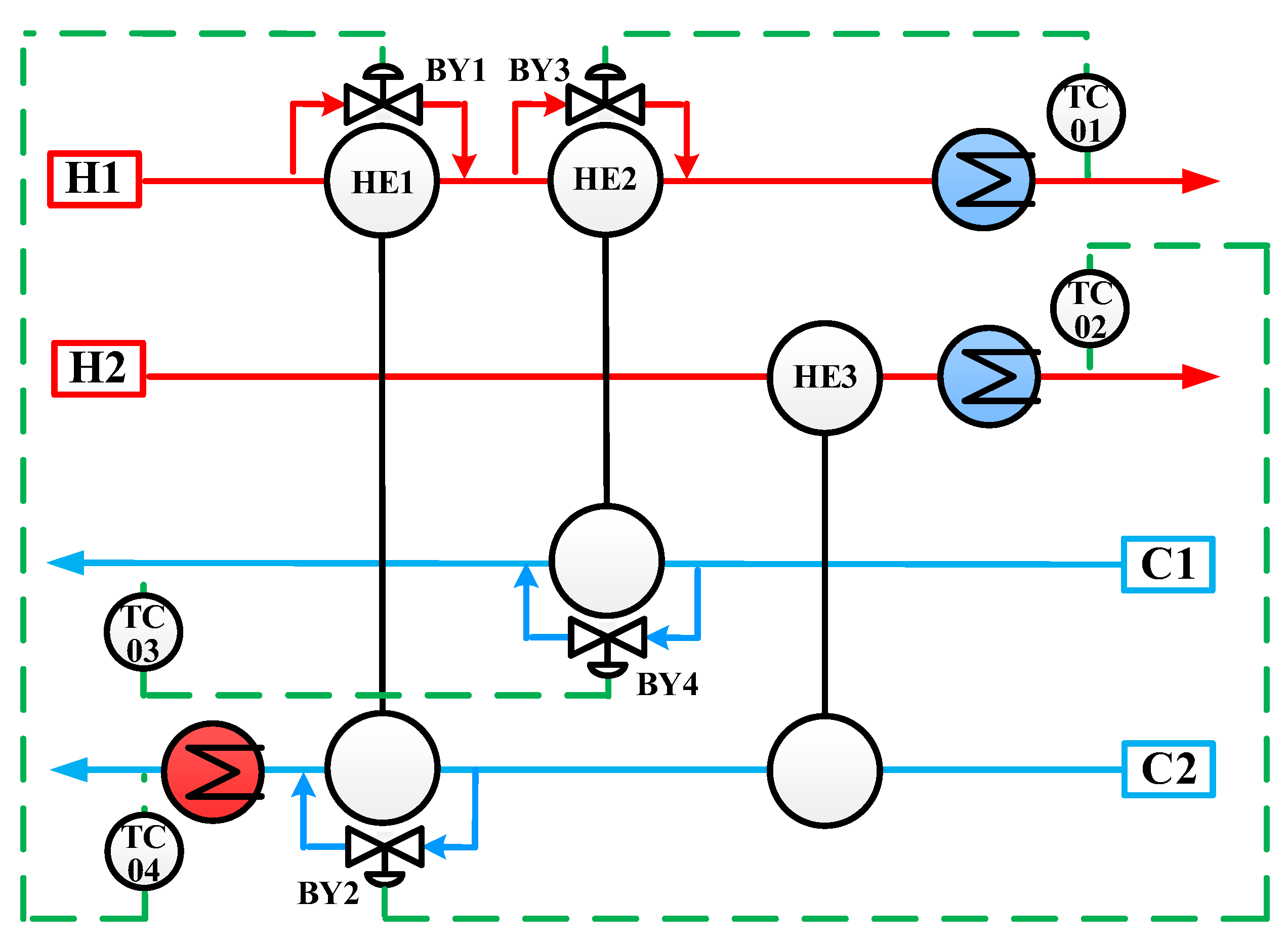

| Stream | TIN (K) | TOUT (K) | Fcp (kW·K−1) | h (kW·m−2·K−1) |
|---|---|---|---|---|
| H1 | 512 | 393 | 7.032 | 1.530 |
| H2 | 512 | 421 | 8.440 | 1.250 |
| C1 | 379 | 423 | 6.096 | 1.470 |
| C2 | 399 | 523 | 10.000 | 1.500 |
| Hot Utility | 850 | 850 | ----- | 2.800 |
| Cold Utility | 293 | 313 | ----- | 3.000 |
| Interval | Optimization Problem Type | ΔTmin of Optimal Solution/(K) | TAC/($·y−1) | RGAn |
|---|---|---|---|---|
| I (5~12 K) | Multi-objective optimization | 7 | 108,227 | 4.464 |
| II (12~28 K) | Single objective optimization | 23 | 114,128 | 4.226 |
| III (28~40 K) | Multi-objective optimization | 37 | 124,410 | 4.597 |
| K1 | K2 | K3 | K4 | |
|---|---|---|---|---|
| HEN1 | 2 | 4 | 0 | 5 |
| HEN2 | 8 | 1 | 4 | 1 |
| HEN3 | 1 | 3 | 4 | 1 |
Publisher’s Note: MDPI stays neutral with regard to jurisdictional claims in published maps and institutional affiliations. |
© 2022 by the authors. Licensee MDPI, Basel, Switzerland. This article is an open access article distributed under the terms and conditions of the Creative Commons Attribution (CC BY) license (https://creativecommons.org/licenses/by/4.0/).
Share and Cite
Gu, S.; Zhuang, X.; Li, C.; Zhang, S.; Wang, J.; Zhuang, Y. Multi-Objective Optimal Design and Operation of Heat Exchanger Networks with Controllability Consideration. Sustainability 2022, 14, 15128. https://doi.org/10.3390/su142215128
Gu S, Zhuang X, Li C, Zhang S, Wang J, Zhuang Y. Multi-Objective Optimal Design and Operation of Heat Exchanger Networks with Controllability Consideration. Sustainability. 2022; 14(22):15128. https://doi.org/10.3390/su142215128
Chicago/Turabian StyleGu, Siwen, Xiuna Zhuang, Chenying Li, Shuai Zhang, Jiaan Wang, and Yu Zhuang. 2022. "Multi-Objective Optimal Design and Operation of Heat Exchanger Networks with Controllability Consideration" Sustainability 14, no. 22: 15128. https://doi.org/10.3390/su142215128
APA StyleGu, S., Zhuang, X., Li, C., Zhang, S., Wang, J., & Zhuang, Y. (2022). Multi-Objective Optimal Design and Operation of Heat Exchanger Networks with Controllability Consideration. Sustainability, 14(22), 15128. https://doi.org/10.3390/su142215128





